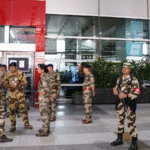Election Commission Slides From Referee to Bystander, Sparking a Democracy Crisis
When Rahul Gandhi took the stage with a blistering one-hour presentation earlier this month, the Election Commission of India was suddenly under heightened scrutiny. Citizens across the country began combing through the electoral rolls, and what they found was staggering.
In Thrissur, Kerala, Prasanna, the sole voter from her home, discovered nine strangers listed at her address. In Palghar, Maharashtra, Sushma Gupta appeared not once, but six times, each under a different EPIC ID. Minta Devi, 34 years old, is registered as 124 in the voter’s list. Across the rolls, the dead seemed to linger and the elderly multiplied: voters aged 110, 115, 124, populating the lists as if democracy itself had ghosts.
These are not just clerical errors. They raise questions. Has the body that is supposed to safeguard India’s democracy become its weakest link? For decades, the Election Commission was a source of pride, a rare institution that stood firm under political pressure. But with every name that does not exist, every duplicate identity, every phantom centenarian and every question about these that remains unanswered, the faith that held it up begins to crumble.
How did the Election Commission, once one of India’s most trusted institutions, become a shadow of itself?
The Emergency test (1975–77)
Until the late 1960s, there was little need for the Election Commission to step in as a strong referee. The Congress party still held overwhelming power, its dominance rooted in the legitimacy it had earned from the freedom struggle.
The real test of the Commission’s authority, however, came in the post-Emergency election. Many feared that the playing field would be tilted in Congress’s favour. Charan Singh, in a note to Jayaprakash Narayan in January 1977, captured the anxiety: “Mrs. Gandhi is thinking of staging an election. I call it ‘staging’ because conditions for a real election – free and fair – will be lacking.”
Despite censorship, repression and Indira’s grip on power, the Election Commission ensured that the 1977 elections were free and fair. The Janata Party swept to power, winning 295 seats in the Lok Sabha. For many, this reaffirmed faith in the Election Commission as an institution capable of protecting democratic choice, even under enormous pressure.
The Kashmir blot (1987)
That faith, however, was shaken a decade later. The 1987 Jammu and Kashmir assembly elections became a defining blot on the Election Commission’s record. Widely regarded as rigged, the elections saw the return of the Congress-National Conference alliance to power, which also deepened public alienation in the valley. Reports of booth capturing, intimidation and mass-scale manipulation, while the Election Commission looked the other way, undermined the legitimacy of the polls. For many Kashmiris, it marked the moment when the ballot lost its meaning, feeding into the insurgency that erupted soon after.
The Seshan era (1990s)
As coalition politics replaced majority rule at the Centre in the 1990s, the Election Commission found room to assert its independence. With the enforcement of the Model Code of Conduct, the Commission began to act as a real guardian of electoral fairness.
No figure symbolised this shift more than T.N. Seshan. In 1991, under his watch, the Election Commission did something unprecedented: it advertised in newspapers asking citizens to come forward with complaints. This was not routine bureaucracy. It was an open invitation for the public to be part of the process. Accountability, transparency and correcting errors were now at the centre of the Commission’s work. Seshan’s no-nonsense style was so feared that a popular joke of the time claimed politicians were scared of only two forces: God and T.N. Seshan.
Maintaining the stride (2000s)
But running elections in a country as vast and complex as India was never easy. Political battles often spilled into confrontations with the Election Commission itself. When the Atal Bihari Vajpayee-led BJP coalition government (1998-2004), for instance, tried to bypass convention by appointing an outsider as chief election commissioner instead of elevating the senior-most commissioner, the sitting members threatened to resign. The government backed down.
The decadal shift
The past decade, however, has been a testing time for the Election Commission of India. Its hard-earned status as referee of Indian democracy has taken a hit, with critics pointing to a steady decline in impartiality. With a majoritarian party holding power at the Centre, the Election Commission appears to have backslid into the habits of its pre-coalition era. A report by the US-based think tank Freedom House put it starkly: “India loses its status as ‘free’… Political rights and civil liberties have worsened since 2014, and the decline has accelerated since 2019.”
In 2020, Ashok Lavasa, the lone Election Commissioner willing to call out the powerful, resigned, reportedly saying that honesty had become “tortuous.” He was the only one dissenting when the Commission cleared Narendra Modi’s and Amit Shah’s speeches, even those filled with communal innuendo. District officers flagged these speeches as violations, and Lavasa argued they broke the very spirit of the Model Code of Conduct. Yet, his voice was drowned out, and soon, the pressure began to mount.
Within months of the BJP’s return, Lavasa’s wife, son, and sister were all served with tax and investigation notices. Under the Pegasus Project, he was identified as a potential target for military-grade surveillance just weeks after his dissent. Lavasa, once a veteran bureaucrat and considered heir-apparent to the post of Chief Election Commissioner, ultimately chose exile over silence. The message was unmistakable—dissent inside the Election Commission is not only ignored but actively hounded out.
In 2021, the Citizens’ Commission on Elections released its inquiry into India’s electoral system. It did not mince words, noting that the ECI had failed to carry out its constitutional duties. The report addressed the exclusion of marginalised groups from voters’ lists, the secrecy surrounding electoral bonds, and the unchecked flow of big money into campaigns. Together, these trends raised troubling questions about whether India was inching towards what Swedish researchers at the V-Dem Institute call an “electoral autocracy”.
Controversy has followed almost every election in recent years. In 2017, opposition parties claimed that voting machines in the UP assembly polls had been tampered with to favour the BJP. The Supreme Court stepped in, directing the Election Commission to verify five VVPAT machines in every constituency. The Commission resisted, before finally conceding.
By 2024, distrust in the Election Commission had hardened. No longer seen as a neutral referee, it appeared more like a bystander unwilling to blow the whistle. Speeches by Narendra Modi, Amit Shah, and Yogi Adityanath tore through the Model Code of Conduct with communal jibes and blatant appeals that once would have drawn swift punishment. Yet, the silence from Nirvachan Sadan was deafening. Citizens waited, opposition parties filed complaints, and civil society gathered outside the Commission’s gates demanding action. The response: static.
When the dam finally broke, it was almost insulting. Instead of holding the leaders themselves accountable, the Commission issued perfunctory notices to their party president. To create a show of balance, a similar notice was sent to the Congress chief as well. For millions of Indians watching, the message could not have been clearer: in this democracy, power shields itself, and the referee has abandoned the field.
What next?
In contrast to Sushma Gupta, there are thousands of names removed from the voters’ list. During the recent Special Intensive Revision in Bihar, over 65 lakh names were removed from the draft voter list. That includes 22 lakh people marked as deceased, 36 lakh listed as unmoved or untraceable, and seven lakh duplicates. Two of those declared ‘dead’ in this list even made their way to the Supreme Court – proving that this exercise left much to be desired.
It is frightening to ask – what next? Has India’s identity as the “Mother of Democracy” slipped backwards after the hard-fought gains of the 1990s and early 2000s? If India is no longer an electoral democracy, then what identity do we carry? What does it mean for us, the citizens of this country? Do we quietly fall in line with nations like Russia or Venezuela, where elections are reduced to empty rituals and the process remains hidden from view? Or does the sheer persistence of citizens and opposition parties, in trying to hold the Election Commission to account, mean that there is still a thread of hope left to cling to?
Also Read: India Sacrifices Cotton Farmers as Trump Tariffs Force Removal of Import Duty








